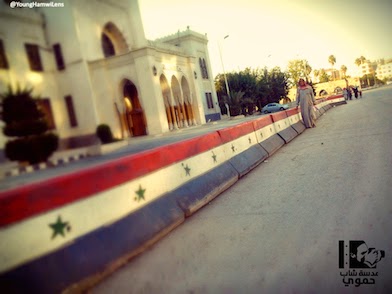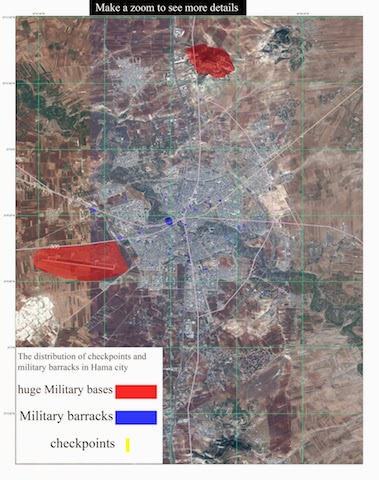Verified
Hama… Where Dreams Die at Security Checkpoints
15:36 Mar 17 2014 Hama, M5, Hama, Syria
Description
prepared & Written by @jasemalhamwe translated by @MaryamSaleh

(A photo from Lens Young Hamwi shows some checkpoints at al Asi Square in Hama)
Like the prisoners of the Moguls and Tatars who, many years ago, tried to break free of their shackles and chains as their captors dragged them away, hoping to regain what was left of their dignity before arriving at the Emperor’s Palace, the city of Hama is struggling to free itself from its shackles at this stage of the Syrian revolution.
History books describe Hama as being an ancient city in the heart of Syria’s central region. It is surrounded by other provinces and does not share a border with any neighboring countries, and has been nicknamed “the cavern of worry” by its people. Hama’s residents have a reputation for rejecting humiliation and subservience, which has caused them to be persecuted by various military forces who have invaded the country over the years, as well as by the tyrants governing Syria. Hama’s people have even been targeted by some of their own.
Over the course of time, great and important events have taken place in the city of Hama, giving it a spot in every period of history.
In the 1980s, Hama was known as “the widow” or “the grieving mother” as a result of the many crimes committed by the Baathist regime, led by Hafez al-Assad with the assistance of his brother Rifaat. The city’s people were targeted for rejecting Baathist practices and for speaking out against them. As a result, the Assad regime committed tens of massacres against the people, under the guise of fighting the Muslim Brotherhood. The Brotherhood ignited an armed uprising in response to Assad’s repression of the people, to which the regime responded by committing massacres in what is often referred to as Hama’s Holocaust. The Syrian Air Force shelled the city while forces on the ground slaughtered, arrested, raped and looted. The regime implemented the “scorched earth” policy in order to draw Hama back into the control of the state, whose only form of dialogue with those who opposed it was violence, a fact that many individuals who spent tens of years locked away in the regime’s dungeons have testified to.
In 2011, the people’s uprising against the Assad regime was ignited, and once again, Hama took part. The city broke free of the darkness that had overcome it for decades, reborn in the pure, white guise of freedom. Million-man marches were held in the city’s Assi Square, where protesters were led in song by Ibrahim Qashoush, whose voice was then heard around the world. The people of Hama took control of the city, setting up their own checkpoints, and shaking the regime at its core. But the white dress that cloaked the city at the start of the revolution soon became stained red by bloodshed.
So where does Hama stand today, after it was occupied by regime forces who supposedly entered to cleanse the city of “terrorists” in August 2011, on the eve of the Muslim holy month of Ramadan?
Regime forces have occupied the city squares and continually patrol its streets, arresting tens of residents, as documented by the Violations Documentation in Syria and the Syrian Network for Human Rights. Arbitrary arrests have become the norm for the people of Hama, as not a single day passes where at least a few people are not arrested.
I think about these issues on a daily basis; as I browse the Internet, meet people from the city, and even now, as I sit in a cafe, sipping my tea and awaiting Mustafa. Mustafa is the pseudonym for a 25-year-old blogger who left behind his studies and his work for at the start of the revolution, which he served by working as a media activist. Today, Mustafa is wanted by the regime’s security apparatus, which is why I can’t disclose any personal details about him.
“We live in a city where one can never be sure when the area he is in will be surrounded and raided [by regime forces], who might arrest a large group of people, or just a specific few whose names ended up on the wanted list by regime informants, who have been planted in every part of the city to eavesdrop on young men, specifically to search for activists and those wanted by regime,” Mustafa said.
Mustafa estimates that there are about 200 military bases and checkpoints (fixed and temporary) in the city. They are located at the entrances to the city and its exits, between its neighborhoods, and even in the middle of city roads. The temporary checkpoints that are arbitrarily set up in at random locations are the most dangerous, because most young men pass near them without being aware of their presence, making them more susceptible to arrest. Like the fixed checkpoints, temporary checkpoints are equipped with computers, which have on them the regime’s wanted lists. Moreover, the forces at the checkpoints use walkie-talkies to communicate directly with their headquarters, where the wanted lists are also available. Most people’s names end up on these lists as a result of confessions forced out of the activists’ friends through torture, or because informants and spies were somehow able to identify these young men as belonging to the anti-regime movement.
Due to these reasons, every morning, Mustafa calls his friends in the other neighborhoods of the city, and checks social networking sites that share the city’s news, to get information about the presence of security forces in the city’s neighborhoods and roads. Mustafa has grown accustomed to taking various paths throughout the city, meanwhile avoiding regime checkpoints and security forces, who have held a strong grip on the city for a very long time.
I asked Mustafa what he means by “informants,” a word he repeated often as he spoke. “Who are they, and what is their purpose?” I asked.
“An informant is a resident of the city who sold his people and his honor in exchange for money or services from the regime,” he said. “Informants provide the regime with information about revolutionary activists or even people who discuss politics, and assist in their arrest.”
“Don’t be surprised if I tell you that an informant can be someone very close to you, or someone you trust with all your secrets,” Mustafa continued. “The Assad regime began recruiting informants in the city after the massacre of 1982, in an attempt to prevent people from discussing the details of the massacre, bringing the crimes to light, or looking into any political ideas that oppose the Baathist regime. For years, we have heard people say ‘The walls have ears,’ which means that the Syrian government knows everything through the unknown eyes and ears it has planted in society.”
Next, I asked Mustafa about the extent of peaceful or armed resistance movements in the city.
“It’s important to note that the million-man marches of Assi Square were put to an end by the Army’s invasion of the city in August 2011,” he said. “After that, we began holding small protests in Hama’s neighborhoods. Some were completely peaceful, and often ended in arrests after being stormed by security forces. Others took place under the protection of the Free Syrian Army, who helped keep security forces away from protesters. We continued holding demonstrations until the crisis that shook Tareeq-Halab neighborhood in April 2013. In the following months, the number of regime forces in the city was at an all-time high, and it was unbelievable. Though the presence of security forces patrolling the city has decreased, various neighborhoods are partially raided on a daily basis. On a typical day, like today for example, three or more neighborhoods were searched and about 20 or more young men were arrested. Sometimes, those who are arrested are released a few hours or days later, while others are still locked away in prison. Not only that, but the regime forces also steal people’s personal belongings on occasion. All of this takes place amid the deployment of temporary checkpoints in some city streets, as security forces roam the streets in their patrol vehicles, or in cars they’ve previously stolen from civilians, until late at night.”
I proceeded to ask Mustafa about the reason security forces so densely populate the city and carry out so many arrests. He said:
“Everyone knows that, since the start of the revolution, the Syrian regime’s goal has been to silence the voices asking for freedom and dignity, opposing the government, and mocking and ridiculing it. The regime’s policy of detaining citizens is carried out in all of Syria, but especially in Hama. Most arrests in the city are arbitrary. Sometimes, the detainees are released after only a few hours or days, during which they are severely humiliated and abused. However, those who have been proven to have ties to the revolution are put through severe torture as they are demanded to give up names of people they work with. When the detainees refuse to give the regime forces they are looking for, the torture often leads to death.”
“What’s interesting is that, recently, armed shabiha who roam around the city in their stolen cars stop young men for no apparent reason and confiscate their cell phones and their money,” Mustafa continued. “The armed militias beat the men they come upon in the street for no reason, and then go about their way. We once documented up to 25 such cases that took place in a single day.”
As I prepared to take my last sip of tea before the close of our conversation, I asked Mustafa a final question. “What is the one dream you wish to accomplish?”
“Before the revolution, each of us had dreams and ambitions that we worked toward,” he said. “However, we abandoned those dreams for the common dream of freedom and dignity.” Mustafa paused before he continued, his voice full of emotion, “On a personal level, I can no longer have have short-term dreams. The dreams and ambitions of any person in Hama can be destroyed in a split second. All it takes is getting stopped at a checkpoint you did not know existed, and then you and your dreams enter into a vast darkness, and the only thing you hope of is seeing light once again.”
——————————————————————————————————————————
• A link to a Google Earth map of Hama, marked with the most important regime checkpoints and military bases (You will need to zoom in to clearly make out the checkpoints):https://mapsengine.google.com/map/edit?mid=z0ZQCFg0M1x4.k_Nbj_Po7MlI
• A link to a photo album containing pictures of regime checkpoints in Hama, courtesy of Young Hamwi Lens:
https://www.dropbox.com/sh/er0dkeailffbkme/QHUrSFK7rp
• A link to a photo album containing photos of Hama’s Military Airport.
https://www.dropbox.com/sh/fy7sokmxdacyb9c/tJDzrXeZRu
• An accurate image from the Syrian Map Center that has been edited with markings to show checkpoints and military bases:

* the Arabic version of that article on Jasem-Alhamwe blog: http://goo.gl/bUE8wF
| Credibility: |  |
 |
0 |
Additional Reports
تقرير جاسم الحموي للعربيةعن نقص الدواء في صيدليات حماة
19:52 Jan 25, 2013
Hama, M5, Hama, Syria, 0 Kms
التكاليف الإضافية.. أعباء جديدة على كاهل المواطن السوري
06:13 Mar 26, 2014
Hama, M5, Hama, Syria, 0 Kms

Leave a Comment